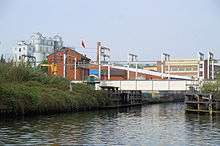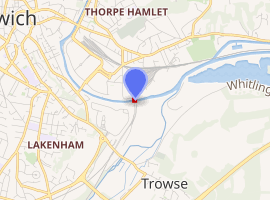Trowse Bridge
Trowse Bridge is a single-track railway bridge which carries the Great Eastern Main Line over the River Wensum just outside Norwich in England at grid reference TG245076.
Trowse Bridge | |
|---|---|
 | |
| Coordinates | 52°37′12″N 1°18′57″E |
| Carries | Great Eastern Main Line |
| Crosses | River Wensum |
| Owner | Network Rail |
| Rail characteristics | |
| No. of tracks | 1 |
| Track gauge | 1,435 mm (56.5 in) |
| History | |
| Constructed by | May Gurney |
| Opened | May 1987 |

| |
The bridge was originally built in 1845 by George Parker Bidder, was rebuilt in 1905[1] and again in 1987. Like many swing bridges, the structure first lifts on hydraulic jacks before swinging open to allow the passage of water traffic.[2] The bridge has frequently caused problems with navigation on the river due to its unreliability, leaving it unable to open.[3]
It is notable for being the only swing bridge in the United Kingdom to carry an overhead electrified railway track (25 kV 50 Hz). Other examples can be found along the Northeast Corridor in the United States; see for instance Portal Bridge, and the Galata Bridge over the Golden Horn in Istanbul. The power supply to trains is provided by an overhead conductor rail instead of a wire, and there are short lengths of overhead conductor rail either side of the bridge on the fixed approaches. There is a 40 mph (64 km/h) speed limit over the bridge in both directions as trains are about to arrive at, or have just departed from, Norwich Station.
The bridge is also the home of Trowse Signal Box, which controls most of the Bittern Line from Whitlingham Junction to Sheringham. The line was resignalled in 2000, leading to the closure of a number of mechanical signal boxes with control moving to Trowse. The resignalling saw the end of one of the few remaining sections of single track main line controlled by tokens.
Construction
.jpg)
.jpg)
The current single track rail bridge on the electrified railway line in to Norwich was designed by the British Rail' Eastern Region based in York. The main contractor was May Gurney of Norwich and they were also the civil works contractor. The Butterley Engineering Company were the fabricators, mechanical contractor and electrical contractor.
The bridge was fabricated and fully trial erected, including a slewing motion trial, inside the Butterley Engineering Company's workshops known as "The Bridge Yard" at Butterley Hill, Ripley in Derbyshire during 1986 and was delivered to site and installed during the winter months of November 1986 to January 1987.
The swing bridge section is approximately 26 metres (85 ft) long, with an off-centre slewing bearing and an underslung counterweight box. The total slew bridge weight was 354 long tons (360 tonnes; 396 short tons), including the counterweight. The counterweight was made from almost 90 long tons (91 t; 100 short tons) of cut up railway track used to precisely balance the structure during the commissioning works. It was necessary for the swing bridge to be balanced about the centre of slew to give equal loading of the 4 main lifting jacks and the span was accurately weighed by 4 x 100 long tons (100 t; 110 short tons) electronic load cells (certified to ±0.5%) February 1987, during the bridge's final installation and commissioning trials.
There are three fixed approach spans at the Norwich city end and the main swing bridge section. The swing bridge raises some 300 millimetres (12 in) on 4 main jacks, mounted on to substantial sub-frame in the turning pit. The swing bridge raises to clear the fixed span and land abutment's scarfed rail joints and to also clear the fixed overhead conductor rails, which are gantry mounted to the swing bridge and the approach spans. The bridge "slew" is provided by 2 hydraulic motors driving against the main slewing ring bearing, manufactured by Robello. The swing bridge section is constructed to be a flat span in the open to rail/service position and not cambered, as are many other bridges.
The old twin-track centre-slew bridge remained in service during the installation and trials of the new bridge until the date the live rail was diverted over the new bridge. The closure and removal of the old bridge in end of February 1987, was during the river's closure to navigation for the bridge replacement, provided for under a specific act of UK Parliament.[4]
References
| Wikimedia Commons has media related to Trowse swing bridge. |
- Redivivus, Brunel (October 1905). "The New Swing Bridge at Trowse". The Railway Magazine. Vol. 17. pp. 316–321. Retrieved 18 April 2019.
- "Statement to EDP". NetworkRailMediaCentre.co.uk. Network Rail. 21 February 2003. Retrieved 18 April 2019.
It weighs around 350 tonnes and works on a system of computer controlled jacks and hydraulic pumps that raise the structure and rotate it to allow river traffic to pass through. It is locked back into place to rejoin the track.
- Leeper, Angie (26 April 2013). Update on Swing Bridges (PDF) (Report). Broads Authority. pp. 8–9. Retrieved 18 April 2019.
From October 2003 to February 2013 Trowse Bridge has been operational 1591 days and has failed 1852 days.
- Trowse Swing Bridge problems Rail issue 78 March 1988 page 15